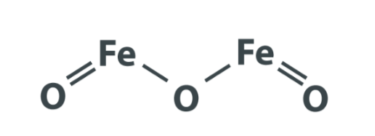
Iron III Oxide Formula: The Iron (III) Oxide Formula comprises Iron and Oxygen elements. Iron, located in group 8 of the periodic table, is a metallic element. It has an atomic number of 26 and is represented by the symbol Fe. Iron is the most commonly used and cost-effective metal, making up a significant portion of the Earth's core. Oxygen, on the other hand, is a highly reactive non-metal and belongs to the chalcogen group on the periodic table. Its atomic number is 8, and it is represented by the symbol O. Oxygen serves as an oxidizing agent and forms oxides when it reacts with various elements.
Iron III Oxide Formula
It's an inorganic compound and one of the most widespread oxides. Its chemical formula is Fe 2 O 3 , and in Latin, Iron is known as Ferrum. Iron can have valencies of 2 and 3. When it combines with a valency of 2, it's referred to as Ferrous, and when it combines with a valency of 3, it's called Ferric. Iron (III) Oxide is naturally occurring in rocks of all ages. Its IUPAC name is Ferric Oxide, and it's also commonly known as Hematite or Red Iron Oxide due to its red-brown colour. This compound is odorless and has a neutral pH value of 7.
Iron III Oxide Formula Structure
Iron (III) oxide is composed of two Iron atoms and three Oxygen atoms. In this compound, Iron is a metal, while Oxygen is a non-metal. Consequently, the bonds formed between Iron and Oxygen are referred to as ionic bonds. The formation of these bonds in Iron (III) oxide is influenced by the difference in electronegativity between the Iron and Oxygen atoms.

Iron III Oxide Formula Name
The Iron III Oxide Formula is Fe 2 O 3 "Iron(III) Oxide". It is commonly referred to as ferric oxide.
Iron III Oxide Formula State
The Iron III Oxide Formula is Fe 2 O 3 . At room temperature and standard conditions, Iron(III) Oxide exists in a solid state.
Production of Iron (III) Oxide Formula
Iron (III) Oxide is obtained through the oxidation of Iron. In laboratory settings, it is prepared by electrolyzing a solution containing sodium bicarbonate, along with an inert electrolyte and an Iron anode.
4Fe + 3O 2 + 2H 2 O → 4FeO(OH)
The resulting hydrated Iron (III) Oxide, FeO(OH), is then dehydrated at 200°C to yield Ferric Oxide.
2FeO(OH) → Fe 2 O 3 + H 2 O
Iron (III) Oxide Physical Properties
- Chemical Formula: Fe 2 O 3
- Molecular Weight: 159.69 grams/mol
- Melting Point: Iron (III) Oxide melts between 1475°C and 1565°C.
- Boiling: When heated, Iron (III) Oxide undergoes decomposition.
- Density: It has a density of 5.242 grams per cubic centimeter (g/cm3).
- Appearance: Iron (III) Oxide is reddish-brown in color and exists in a solid state at room temperature.
- Odor: It is odorless.
- Electrical Conductivity: Iron (III) Oxide does not conduct electricity.
Iron (III) Oxide Chemical Properties
Solubility: Iron (III) Oxide is insoluble in water but can dissolve in strong acids.
Formation of Ferric Hydroxide: When it dissolves in water, it creates a weak base known as Ferric Hydroxide.
Oxidation State: The oxidation state of Iron in this oxide is +3.
Carbothermal Reduction: Iron (III) Oxide can be reduced with a substance like carbon to obtain the metal within the oxide, which is Iron.
This method is applicable to various metal oxides.
Fe 2 O 3 + 3CO → 2Fe + 3CO 2
Exothermic Thermite Reaction: When Iron (III) Oxide reacts with Aluminium, it undergoes an exothermic thermite reaction, producing Iron and Aluminium oxide.
2Al + Fe 2 O 3 → 2Fe + Al 2 O 3
Practical Uses of Iron (III) Oxide
Iron Production: Ferric oxide serves as a raw material in the manufacturing of iron.
Jewellery Polishing: It's employed for the final polishing of metal jewellery and also as a pigment.
Calamine Lotion: Ferric oxide plays a crucial role in calamine lotion as an ingredient.
Magnetic Media: It finds application in magnetic disks and tapes.
Cosmetics: Iron (III) Oxide is used in the cosmetics industry.
Dental Composites: It is utilized in dental composites for various dental applications.
| Related Link | |
| Sulfate Ion Formula | Sulfur Trioxide Formula |
| Zinc Sulfate Formula | Zinc Nitrate Formula |
Iron III Oxide Formula FAQs
What is the chemical formula for Iron (III) Oxide?
What is the common name for Fe2O3?
What is the natural colour of Iron (III) Oxide?
What are the elements present in Iron (III) Oxide?
What type of bonds are found in Iron (III) Oxide?










